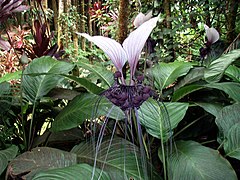| Habit | herbaceous
| |
|---|---|---|
| Lifespan: | ⌛ | perennial |
| Features: | ✓ | flowers, foliage |
|---|---|---|
| Flower features: | ❀ | purple, brown, black |
|
Tacca > |
Tacca is a genus of ten species of flowering plants in the order Dioscoreales, native to tropical regions of Africa, Australia, and south-eastern Asia.
Several species are cultivated as ornamental plants for their bold foliage and large flowers.
Read about Tacca in the Standard Cyclopedia of Horticulture
|
|---|
|
Tacca (Malayan name). Syn., Ataccia. Perennial herbs from a tuberous or creeping rhizome, adapted to the warmhouse. Leaves radical, large, petioled, sometimes undivided and entire, sometimes variously lobed or dissected: fls. at the top of erect leafless scapes in dense umbels, lurid brown or greenish; perianth 6-lobed in 2 rows; stamens 6; ovary inferior, 1-celled: fr. globose, ovoid, turbinate or elongated, usually 3-cornered or 6-ribbed, berry-like and indehiscent, rarely finally 3-valved.—About 13 species in the tropics of both hemispheres. The fl.- cluster is subtended by a few, usually 4, leaf-like or colored bracts, and intermixed with the fls. are more or less numerous, long and conspicuous, sterile, filiform pedicels, which usually droop below the fl.-cluster. Taccaceae contains only one other genus, Schizocapsa. CH
|
Cultivation
- Do you have cultivation info on this plant? Edit this section!
Propagation
- Do you have propagation info on this plant? Edit this section!
Pests and diseases
- Do you have pest and disease info on this plant? Edit this section!
Species
Selected species
- Tacca chantrieri André - Bat flower
- Tacca flabellata J.J.Sm.
- Tacca integrifolia Ker Gawl.
- Tacca leontopetaloides Kuntze
- Tacca palmata Blume
- Tacca plantaginea (Hance) Drenth
In older texts, the genus was treated in its own family Taccaceae, but the 2003 APG II system incorporates it into the family Dioscoreaceae.
Gallery
References
- Standard Cyclopedia of Horticulture, by L. H. Bailey, MacMillan Co., 1963
External links
- w:Tacca. Some of the material on this page may be from Wikipedia, under the Creative Commons license.
- Tacca QR Code (Size 50, 100, 200, 500)
